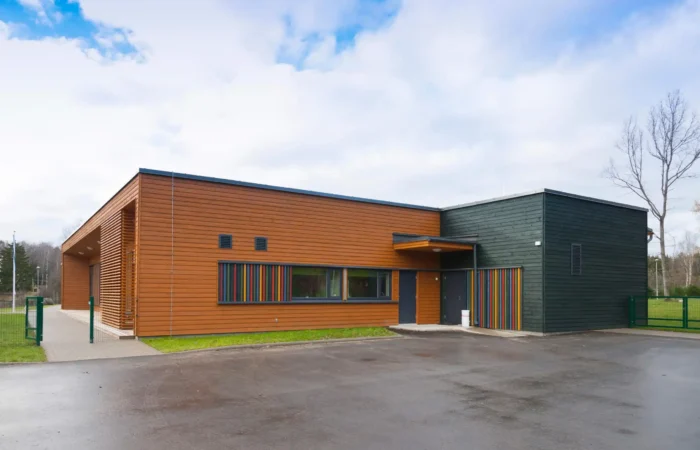
How Do I Select the Best Paint Type for My Commercial Building?
Selecting the right paint for your office or industrial building goes beyond just color—it’s about creating a welcoming environment that lasts. Our guide makes it easy, providing practical tips to ensure your space looks great and stands up to the demands of your business.
The best paint kind is of great importance for an office or industrial building, concerning not only the appearance but also the lifespan of the surface. The right decision is able to give a building an impressive look, to protect its surfaces from the elements and to affect the mental health of people inside. Between different options there is a choice of the paint that is affected by climate, the purposes of building and maintenance requirements. By providing a step-by-step guide for selecting the optimal paint type for your commercial building, we seek to minimise complexity and offer practical tips to guarantee long-lasting brightening of the walls.
Factors to Consider Before Selecting Paint Type for Commercial Building
Need Help?
Ready to make a lasting impression? Let’s select the ideal paint that suits your building’s purpose.
*Consult with Our Paint Experts Today with a Free Consultaion!
- Durability and Performance
- Surface Material
- Environmental Conditions
- Health and Safety Regulations
7 Strategies to Select the Best Paint Type for Your Commercial Building
- Consult a Colour Consultant
A colour consultant may help you choose the color patterns that match your commercial building’s style, goals, and setting. They can help you to choose the colours that will outlive trend change and that are loved by your main consumers, thus improving your building appearance.
- Prioritize Quality Over Price
- Consider the Building’s Use
- Evaluate Light Reflection
The level of natural and artificial light that a room gets can extensively transform a way a shade of paint looks. Take into account the kind of lightings in your building when choosing the paint colour in order to maintain the same pigment and obtain the desired result under the different lighting conditions.
- Test Paint Samples
- Check for Environmental Certifications
- Factor in Maintenance and Cleaning
Tips for Budgeting for Your Paint Project
Budgeting accurately for your commercial building painting project ensures that you can achieve the desired outcome without unexpected expenses derailing the process. Here are some tips to help you plan your budget effectively:
- Get Multiple Quotes
- Include a Contingency Fund
- Choose the Right Time of Year
The painting costs would be seasonal. One of the advantages of scheduling your project during the off-peak season is that you will be more likely to get a discount from the contractors who would be willing to take up projects during this period to fill in their workload. However, keep the timing in mind so it does not sever the quality of the work.
- Do Some Prep Work Yourself
- Invest in Quality for Longevity
Frequently Asked Questions
The optimum finish for the paintwork on a commercial building is usually determined by the area to be painted. Grass surfaces and high-trafficked areas should be painted with either semi-gloss or gloss finish due to the ease of cleaning and resilience. Matte or flat finish may be the ideal option when it comes to uneven walls in low-traffic areas, because they are very good at hiding unseens.
The paint lifespan depends on paint type, the surface it is applied to, and the weather and traffic exposure of a given building. An average high-quality commercial painting job has a lifetime of 5 to 10 years. The replacement of batteries can be avoided by proper maintenance and regular touch-ups. This significantly prolongs the overall lifespan of the batteries.

 Danyelli Rosa2023-08-23On behalf of Peter A. - Committee Member of Birkenhead Quays I have been in the building industry industry for over 50 years, I have never seen a building of this size being completed two months ahead of schedule and under budget. Thanks to Vincent and Yusif they have been amazing. CPR team are true professionals with qualified trade people. Out of 148 apartments not 1 complaint. I would highly recommend them if you want friendly and hassle free servers.
Danyelli Rosa2023-08-23On behalf of Peter A. - Committee Member of Birkenhead Quays I have been in the building industry industry for over 50 years, I have never seen a building of this size being completed two months ahead of schedule and under budget. Thanks to Vincent and Yusif they have been amazing. CPR team are true professionals with qualified trade people. Out of 148 apartments not 1 complaint. I would highly recommend them if you want friendly and hassle free servers. Birkenhead Quays2023-08-21I am the Building Manager for Birkenhead Quays in Drummoyne NSW. I am absolutely thrilled to share my incredible experience with CPR! Every aspect of their work, from the initial consultation to the final brushstroke, exuded a sense of excellence. The attention to detail they displayed was remarkable; it was evident that they took great pride in delivering flawless results. What truly sets CPR apart is their commitment to understanding and meeting their clients' needs. They took the time to listen to our vision and preferences, incorporating them seamlessly into their approach. The final result was a masterpiece that exceeded all our expectations. Furthermore, their professionalism and punctuality were second to none. Deadlines were not only met but surpassed, showcasing their dedication to providing a seamless and stress-free experience. Their team worked efficiently and neatly, ensuring that our building was left even more immaculate than when they arrived. CPR is a shining beacon of excellence. If you're looking for a painting company that delivers unwavering professionalism, and a truly remarkable experience, look no further. I am beyond grateful for their exceptional work and can't recommend them highly enough. A big thank you to Vicente, Hussain, Namat, Yusif, Dinesh and Mark on this project. Sincerely, Danyelli Rosa - Birkenhead Quays
Birkenhead Quays2023-08-21I am the Building Manager for Birkenhead Quays in Drummoyne NSW. I am absolutely thrilled to share my incredible experience with CPR! Every aspect of their work, from the initial consultation to the final brushstroke, exuded a sense of excellence. The attention to detail they displayed was remarkable; it was evident that they took great pride in delivering flawless results. What truly sets CPR apart is their commitment to understanding and meeting their clients' needs. They took the time to listen to our vision and preferences, incorporating them seamlessly into their approach. The final result was a masterpiece that exceeded all our expectations. Furthermore, their professionalism and punctuality were second to none. Deadlines were not only met but surpassed, showcasing their dedication to providing a seamless and stress-free experience. Their team worked efficiently and neatly, ensuring that our building was left even more immaculate than when they arrived. CPR is a shining beacon of excellence. If you're looking for a painting company that delivers unwavering professionalism, and a truly remarkable experience, look no further. I am beyond grateful for their exceptional work and can't recommend them highly enough. A big thank you to Vicente, Hussain, Namat, Yusif, Dinesh and Mark on this project. Sincerely, Danyelli Rosa - Birkenhead Quays Judy P2023-07-26High quality work, customer-focused service, impressive outcomes. Project Manager Vicente Barba and his team were professional and responsive.
Judy P2023-07-26High quality work, customer-focused service, impressive outcomes. Project Manager Vicente Barba and his team were professional and responsive. Fran Lubotzky2023-03-10This company is outstanding!! So professional, such great communication, such clean, tidy and brilliant work painting our very high and large building with next to no disruption, hassle or inconvenience. I highly recommend this company. Fran
Fran Lubotzky2023-03-10This company is outstanding!! So professional, such great communication, such clean, tidy and brilliant work painting our very high and large building with next to no disruption, hassle or inconvenience. I highly recommend this company. Fran Ross Elsley2022-08-01We live by the sea and CPR completed painting of the exterior of our Strata Building in 2015. Seven (7) years later, it still looks great.
Ross Elsley2022-08-01We live by the sea and CPR completed painting of the exterior of our Strata Building in 2015. Seven (7) years later, it still looks great. Andrew Digby2022-06-23Cannot fault this company. They were professional and polite and keep the occupants well informed as to their activities! Our building looks like new again. The employees are friendly and helpful.
Andrew Digby2022-06-23Cannot fault this company. They were professional and polite and keep the occupants well informed as to their activities! Our building looks like new again. The employees are friendly and helpful. Bevo2022-06-19We have just recently had our building facade painted by the team from CPR. The building was built in 1969 and is 8 stories in height - the abseiling worked perfectly for the job. Over 30 years I have been involved in many major projects and the guys from CPR were delightful to work with. The team was led by Vicente and nothing was a problem - the guys were always there to help. The response from other residents in the building is the same - everyone thought all the guys on the job were very friendly, punctual, polite and super obliging. The communications throughout the job was always open with weekly site meetings. We have had positive comments from many of our neighbours about the fantastic result and I would not hesitate to recommend CPR. Katrina
Bevo2022-06-19We have just recently had our building facade painted by the team from CPR. The building was built in 1969 and is 8 stories in height - the abseiling worked perfectly for the job. Over 30 years I have been involved in many major projects and the guys from CPR were delightful to work with. The team was led by Vicente and nothing was a problem - the guys were always there to help. The response from other residents in the building is the same - everyone thought all the guys on the job were very friendly, punctual, polite and super obliging. The communications throughout the job was always open with weekly site meetings. We have had positive comments from many of our neighbours about the fantastic result and I would not hesitate to recommend CPR. Katrina Renee Goossens2022-05-24Our experience with Facade upgrade specialists was excellent. The attention to detail wonderful. The entire performance was faultless. The team worked diligently with care and precision as they quietly abseiled down our building. It was a long job over two buildings but it was noteworthy that Abdul and his team worked long hours here. There were no raised voices and than goodness no loud radios. For fifteen months, partly due to Covid, our building seemed to be under siege. Scaffolding had been required by the noisy team who needed to remove then our combustible cladding. Having your Facade team was sheer delight after what had previously been a rude and noisy ordeal. Bravo to you all. Thanks for your good work.
Renee Goossens2022-05-24Our experience with Facade upgrade specialists was excellent. The attention to detail wonderful. The entire performance was faultless. The team worked diligently with care and precision as they quietly abseiled down our building. It was a long job over two buildings but it was noteworthy that Abdul and his team worked long hours here. There were no raised voices and than goodness no loud radios. For fifteen months, partly due to Covid, our building seemed to be under siege. Scaffolding had been required by the noisy team who needed to remove then our combustible cladding. Having your Facade team was sheer delight after what had previously been a rude and noisy ordeal. Bravo to you all. Thanks for your good work. Margaret Freemantle2022-05-10This company is so professional and passionate about their work, as well as being obliging and helpful. A pleasure to have this team painting our building. With thanks.
Margaret Freemantle2022-05-10This company is so professional and passionate about their work, as well as being obliging and helpful. A pleasure to have this team painting our building. With thanks.



